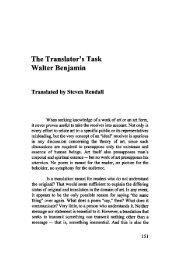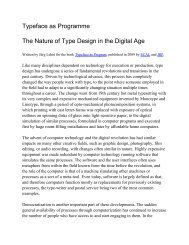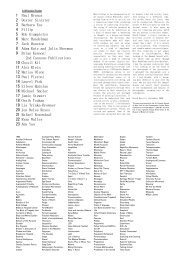Konstnären och kulturnäringarna Artists and the Arts Industries
Konstnären och kulturnäringarna Artists and the Arts Industries
Konstnären och kulturnäringarna Artists and the Arts Industries
You also want an ePaper? Increase the reach of your titles
YUMPU automatically turns print PDFs into web optimized ePapers that Google loves.
Yudhishthir Raj Isar | Problems with <strong>the</strong> Paradigm Yudhishthir Raj Isar | Problems with <strong>the</strong> Paradigm<br />
From ‘cultural’ to ‘creative’… 15<br />
The term ‘cultural industries’ began to be used in France <strong>and</strong><br />
at UNESCO in <strong>the</strong> late 1970s <strong>and</strong> <strong>the</strong>n spread to Britain in <strong>the</strong><br />
1980s. It concerned <strong>the</strong> arts <strong>and</strong> heritage (including cultural<br />
tourism) <strong>and</strong> <strong>the</strong> crafts seen within an agenda of economic <strong>and</strong><br />
social welfare: <strong>the</strong> subsidized arts as public goods, with an additional<br />
emphasis on applied arts practices in fields such as urban<br />
regeneration, audience development, community development<br />
<strong>and</strong> <strong>the</strong> like. Indeed, it was with such regenerative goals in mind<br />
that <strong>the</strong> notion began to be used by <strong>and</strong> for <strong>the</strong> Greater London<br />
Council in <strong>the</strong> early 1980s. This early usage was cognizant<br />
of <strong>the</strong> far earlier <strong>and</strong> highly critical Frankfurt School’s ‘culture<br />
industries’ <strong>the</strong>orizing <strong>and</strong> <strong>the</strong>refore contained a degree of apprehension,<br />
even disdain, with regard to cultural goods <strong>and</strong> services<br />
targeting mass society, through forms of industry that could trivialize<br />
art <strong>and</strong> popular culture alike. This made it necessary for<br />
<strong>the</strong> public cultural institutions <strong>and</strong> agencies to defend art from<br />
<strong>the</strong> negative effects of both <strong>the</strong> market <strong>and</strong> <strong>the</strong> masses, while<br />
at <strong>the</strong> same time harnessing <strong>the</strong> former <strong>and</strong> providing greater<br />
access to <strong>the</strong> latter.<br />
The ‘creative industries’, a broader category, crystallized<br />
15 See <strong>the</strong> excellent historical overview in Justin O’Connor’s The Creative<br />
<strong>Industries</strong>: A Review of <strong>the</strong> Literature (2007).<br />
later, around <strong>the</strong> new technologies as well as <strong>the</strong> ‘knowledge<br />
economy’, yet focused more than its predecessor on <strong>the</strong> forprofit<br />
or commercial sector – thus embracing advertising, interactive<br />
leisure software <strong>and</strong> so forth. In <strong>the</strong> late 1990s, <strong>the</strong><br />
British Government’s Department of Culture, Media <strong>and</strong> Sport<br />
foregrounded <strong>the</strong> notion in its vision <strong>and</strong> rhetoric, giving it<br />
considerable purchase in <strong>the</strong> English-speaking world. 16 A great<br />
boost to <strong>the</strong> ‘creative’ in <strong>the</strong> term was <strong>the</strong>n provided, <strong>and</strong> projected<br />
internationally, via Richard Florida’s 2002 bestseller The<br />
Rise of <strong>the</strong> Creative Class <strong>and</strong> how it’s transforming work, leisure,<br />
community, & everyday life. Florida’s <strong>the</strong>ses were taken<br />
up enthusiastically by many government officials, politicians<br />
<strong>and</strong> cultural activists <strong>the</strong> world over – <strong>and</strong> despite <strong>the</strong> obvious<br />
vastness <strong>and</strong> imprecision of <strong>the</strong> ‘creative class’ notion he was<br />
using, which stretches across a very broad range of ra<strong>the</strong>r different<br />
professions <strong>and</strong> occupations indeed, including scientists,<br />
engineers, architects, educators, writers, artists, <strong>and</strong> entertainers.<br />
In o<strong>the</strong>r words, all those whose economic function is to<br />
create new ideas, new technology, <strong>and</strong> new creative content are<br />
now part of <strong>the</strong> ‘creative class’, even though <strong>the</strong> actual economic<br />
16 It defined <strong>the</strong> creative industries as comprising ‘those industries that<br />
have <strong>the</strong>ir origin in individual creativity, skill <strong>and</strong> talent <strong>and</strong> which have <strong>the</strong><br />
potential for wealth <strong>and</strong> job creation through <strong>the</strong> generation <strong>and</strong> exploitation<br />
of intellectual property.’<br />
<strong>and</strong> social circumstances of <strong>the</strong> various professions <strong>and</strong> groups<br />
so subsumed vary widely. Florida’s argument found such wide<br />
<strong>and</strong> enthusiastic acceptance because of <strong>the</strong> positive, proactive<br />
policy stance implied <strong>and</strong> <strong>the</strong> way it presented <strong>the</strong> creative class<br />
as a panacea for urban regeneration <strong>and</strong> attractivity. Thus city<br />
<strong>and</strong> regional authorities began to turn as a matter of routine to<br />
place-marketing strategies that rely increasingly on cultural offer,<br />
in o<strong>the</strong>r words on <strong>the</strong> presence of artists, creative people <strong>and</strong><br />
<strong>the</strong> cultural industries as forms of symbolic capital that exert a<br />
strong attraction on international companies <strong>and</strong> <strong>the</strong>ir mobile<br />
workforces. Thus urban ‘quality of life’ has come to be seen as a<br />
key ingredient for ‘city br<strong>and</strong>ing’, including international strategies<br />
to attract capital <strong>and</strong> skills, <strong>and</strong> cities <strong>and</strong> regions now take<br />
it increasingly for granted that <strong>the</strong>y must build international<br />
competitive advantage in <strong>the</strong> cultural products sectors.<br />
Such processes have led to <strong>the</strong> replacement of public sector<br />
provision <strong>and</strong> management by a variety of private, voluntary <strong>and</strong><br />
semi-public agencies <strong>and</strong> initiatives – as is clearly <strong>the</strong> purpose<br />
of <strong>the</strong> Swedish action plan. New strategies to mobilize local potential<br />
for economic growth now include actors o<strong>the</strong>r than those<br />
associated with traditional municipal policies. In <strong>the</strong>se new partnership<br />
processes, bargaining systems have emerged which require<br />
more co-operative structures <strong>and</strong> styles of policy making.<br />
A clash of values<br />
Returning now to a point referred to earlier, it cannot be taken for<br />
granted that economic value is coterminous with cultural value.<br />
Whe<strong>the</strong>r he is a composer, a painter or a playwright, <strong>the</strong> artist<br />
always has to consider <strong>the</strong> alternative between producing a work<br />
in his artistic medium that emerges out of <strong>the</strong> pure pursuit of<br />
his artistic vision <strong>and</strong> one that meets <strong>the</strong> dem<strong>and</strong>s of <strong>the</strong> market<br />
more closely which <strong>the</strong>refore makes it more commercially saleable.<br />
Tensions can arise between <strong>the</strong> imperatives of <strong>the</strong> marketplace<br />
<strong>and</strong> <strong>the</strong> values inherent in <strong>the</strong> artistic act – <strong>and</strong> today <strong>the</strong>se<br />
tensions are exacerbated by globalization. Some of <strong>the</strong>se tensions<br />
were addressed in <strong>the</strong> form of questions posed in <strong>the</strong> Introduction<br />
to my edited volume entitled Cultural Expression, Creativity<br />
<strong>and</strong> Innovation (Anheier <strong>and</strong> Isar, 2010) <strong>and</strong> some answers were<br />
provided by <strong>the</strong> contributors to <strong>the</strong> volume. What does creativity<br />
mean in a globalizing economic, cultural <strong>and</strong> artistic l<strong>and</strong>scape?<br />
How does creativity manifest itself empirically, <strong>and</strong> what are <strong>the</strong><br />
economic, sociological <strong>and</strong> cultural factors that help account for<br />
variations in creativity across genres, fields, regions, <strong>and</strong> societies<br />
over time? Are transnational milieus <strong>and</strong> clusters of creativity<br />
emerging? What institutions, organizations <strong>and</strong> professions as<br />
well as artistic, political or economic interests are behind such<br />
milieus, <strong>and</strong> how are <strong>the</strong>y interlinked? Is <strong>the</strong> changing ‘map’ of<br />
creativity related to <strong>the</strong> various drivers <strong>and</strong> patterns of globalization?<br />
How does cultural/artistic creativity differ from creativity in<br />
o<strong>the</strong>r fields, in particular <strong>the</strong> sciences, <strong>the</strong> business world <strong>and</strong> in<br />
politics? Questions of agency <strong>and</strong> dominance also arise. How do<br />
certain actors seek to encourage, control or discourage creativity<br />
as a matter of policy? How do such effects occur unintentionally?<br />
Is cultural expression becoming homogenized across <strong>the</strong> world<br />
as a result of globalization? What countervailing forces, if any,<br />
challenge <strong>the</strong> hegemonies? Who are <strong>the</strong> cultural-political entrepreneurs,<br />
institutions <strong>and</strong> organizations in this respect, <strong>and</strong> how<br />
32 33









